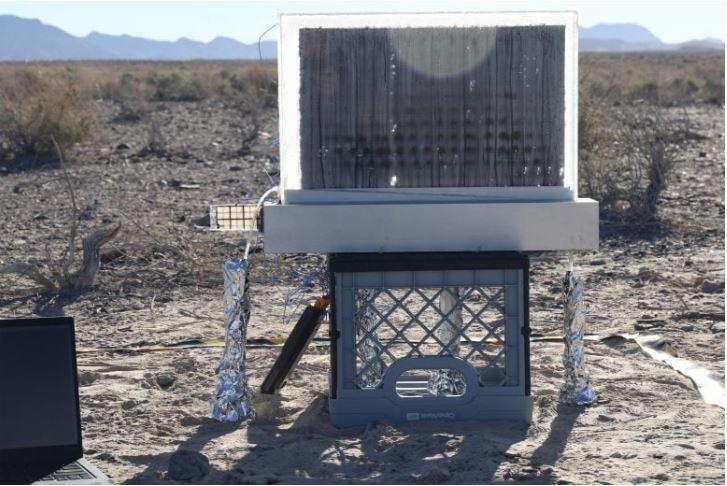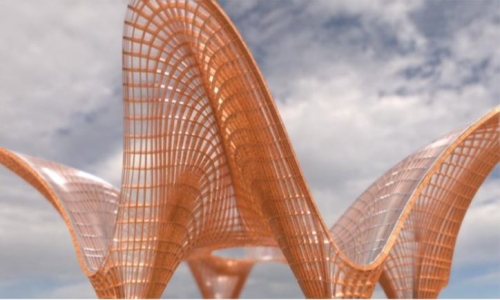


 11:26:19
11:26:19  2025-06-21
2025-06-21  890
890

Today, 2.2 billion people around the world do not have access to safe drinking water. In the United States, over 46 million people face water insecurity, living without running water or relying on supplies that are unsafe to drink. As demand for clean water grows, traditional sources like rivers, lakes, and reservoirs are being pushed to their limits.
To help address this challenge, MIT engineers are exploring an alternative source: the air. Earth’s atmosphere holds trillions of gallons of water in the form of vapor. If this vapor can be captured and condensed efficiently, it could provide clean drinking water in areas where traditional supplies are unavailable.
Working toward that goal, the MIT team has developed and tested a new atmospheric water harvester that successfully captures vapor and produces safe drinking water across a range of humidity levels, including extremely dry desert air.
The device is a black, vertical panel about the size of a window. It is made of a water-absorbing hydrogel and enclosed in a glass chamber coated with a cooling material. The hydrogel, which looks like black bubble wrap, features small dome-like shapes that swell as they absorb water vapor. When the vapor evaporates, the domes shrink in an origami-like motion. The vapor condenses on the glass surface and flows through a tube as clean, drinkable water.
Unlike other systems that rely on batteries, solar panels, or electricity, this device operates entirely on its own. The team tested it for more than a week in Death Valley, California—the driest area in North America. Even under low-humidity conditions, it produced up to 160 milliliters of drinking water per day, roughly two-thirds of a cup.
The team estimates that multiple vertical panels, set up in a small array, could passively supply a household with drinking water, even in arid desert environments. What’s more, the system’s water production should increase with humidity, supplying drinking water in temperate and tropical climates.
“We have built a meter-scale device that we hope to deploy in resource-limited regions, where even a solar cell is not very accessible,” says Xuanhe Zhao, the Uncas and Helen Whitaker Professor of Mechanical Engineering and Civil and Environmental Engineering at MIT. “It’s a test of feasibility in scaling up this water harvesting technology. Now people can build it even larger, or make it into parallel panels, to supply drinking water to people and achieve real impact.”
Zhao and his colleagues present the details of the new water harvesting design in a paper appearing in the journal Nature Water. The study’s lead author is former MIT postdoc “Will” Chang Liu, who is currently an assistant professor at the National University of Singapore (NUS). MIT co-authors include Xiao-Yun Yan, Shucong Li, and Bolei Deng, along with collaborators from multiple other institutions.
Carrying capacity
Hydrogels are soft, porous materials that are made mainly from water and a microscopic network of interconnecting polymer fibers. Zhao’s group at MIT has primarily explored the use of hydrogels in biomedical applications, including adhesive coatings for medical implants, soft and flexible electrodes, and noninvasive imaging stickers.
“Through our work with soft materials, one property we know very well is the way hydrogel is very good at absorbing water from air,” Zhao says.
Researchers are exploring a number of ways to harvest water vapor for drinking water. Among the most efficient so far are devices made from metal-organic frameworks, or MOFs — ultra-porous materials that have also been shown to capture water from dry desert air. But the MOFs do not swell or stretch when absorbing water, and are limited in vapor-carrying capacity.
Water from air
The group’s new hydrogel-based water harvester addresses another key problem in similar designs. Other groups have designed water harvesters out of micro- or nano-porous hydrogels. But the water produced from these designs can be salty, requiring additional filtering. Salt is a naturally absorbent material, and researchers embed salts — typically, lithium chloride — in hydrogel to increase the material’s water absorption. The drawback, however, is that this salt can leak out with the water when it is eventually collected.
The team’s new design significantly limits salt leakage. Within the hydrogel itself, they included an extra ingredient: glycerol, a liquid compound that naturally stabilizes salt, keeping it within the gel rather than letting it crystallize and leak out with the water. The hydrogel itself has a microstructure that lacks nanoscale pores, which further prevents salt from escaping the material. The salt levels in the water they collected were below the standard threshold for safe drinking water, and significantly below the levels produced by many other hydrogel-based designs.
In addition to tuning the hydrogel’s composition, the researchers made improvements to its form. Rather than keeping the gel as a flat sheet, they molded it into a pattern of small domes resembling bubble wrap, that act to increase the gel’s surface area, along with the amount of water vapor it can absorb.
The researchers fabricated a half-square-meter of hydrogel and encased the material in a window-like glass chamber. They coated the exterior of the chamber with a special polymer film, which helps to cool the glass and stimulates any water vapor in the hydrogel to evaporate and condense onto the glass. They installed a simple tubing system to collect the water as it flows down the glass.
In November 2023, the team traveled to Death Valley, California, and set up the device as a vertical panel. Over seven days, they took measurements as the hydrogel absorbed water vapor during the night (the time of day when water vapor in the desert is highest). In the daytime, with help from the sun, the harvested water evaporated out from the hydrogel and condensed onto the glass.
Over this period, the device worked across a range of humidities, from 21 to 88 percent, and produced between 57 and 161.5 milliliters of drinking water per day. Even in the driest conditions, the device harvested more water than other passive and some actively powered designs.
“This is just a proof-of-concept design, and there are a lot of things we can optimize,” Liu says. “For instance, we could have a multi-panel design. And we’re working on a next generation of the material to further improve its intrinsic properties.”
“We imagine that you could one day deploy an array of these panels, and the footprint is very small because they are all vertical,” says Zhao, who has plans to further test the panels in many resource-limited regions. “Then you could have many panels together, collecting water all the time, at household scale.”
Reality Of Islam |
|

A new NURBS

A research

Researchers
 9:3:43
9:3:43
 2018-11-05
2018-11-05
10 benefits of Marriage in Islam
 7:5:22
7:5:22
 2019-04-08
2019-04-08
benefits of reciting surat yunus, hud &
 9:45:7
9:45:7
 2018-12-24
2018-12-24
advantages & disadvantages of divorce
 11:35:12
11:35:12
 2018-06-10
2018-06-10
 6:0:51
6:0:51
 2018-10-16
2018-10-16
 3:42:22
3:42:22
 2021-12-24
2021-12-24
 10:55:53
10:55:53
 2022-06-13
2022-06-13
 9:30:2
9:30:2
 2021-11-12
2021-11-12
 2:33:4
2:33:4
 2023-02-15
2023-02-15
 2:42:26
2:42:26
 2023-02-02
2023-02-02
 7:6:7
7:6:7
 2022-03-21
2022-03-21
 6:14:17
6:14:17
 2018-06-21
2018-06-21
 5:41:46
5:41:46
 2023-03-18
2023-03-18
| LATEST |